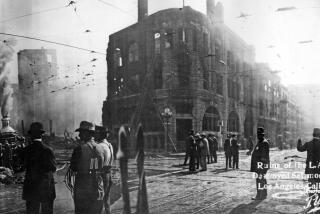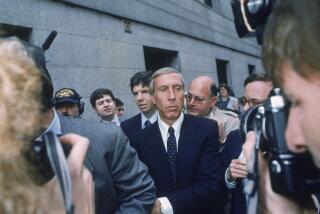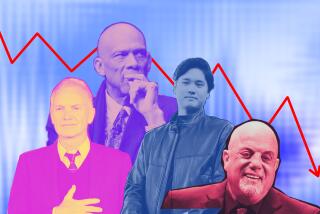Enron’s press pass
DURING the trial that ended Thursday with their conviction on fraud and other charges, former Enron bosses Kenneth L. Lay and Jeffrey K. Skilling insisted that the weight of unjustifiably critical newspaper stories helped bring their once high-flying company crashing to Earth.
We now know, of course, that Enron was essentially a hall of mirrors held together by the accountants’ sleight of hand, criminal conspiracy and garden variety deceit. It would be reassuring to believe -- and Lay and Skilling were at least partially correct -- that we came to know all this because vigorous and skeptical reporting informed us of the facts.
It isn’t so.
The American press failed badly and generally not only on the Enron story, but also on those of WorldCom, Tyco, Rite Aid, Adelphia, HealthSouth and most of the corporate debacles that followed on the heels of the Houston energy trader’s bankruptcy. It’s worth asking why on a couple of counts:
As James Post, a professor of management at Boston University, told the New York Times on Thursday, “Enron is one of the great frauds in American business history.... It also is a symbol of a particular era of management practice. The excesses of Enron point pretty clearly to what was going on in mainstream companies across the business landscape in the 1990s.”
They also point to what wasn’t going on among most of the nation’s financial journalists most of the time in those years. The late 1990s weren’t just a boom time for the U.S. economy; they also were years in which the numbers of reporters and editors assigned to cover business seemed to grow exponentially and the prominence given their work increased right along with the Dow. When you went into a barbershop, you were at least as likely to find the television tuned to CNBC as ESPN -- at least until the trading day closed.
So why -- until the Wall Street Journal began its telling reports on Enron’s final slide toward oblivion -- weren’t the investors who lost $60 billion or the more than 5,000 employees who lost their jobs and, in many cases, their life savings, warned about the company’s dubious behavior?
One of the answers has to do with inherent limitations the press often is loath to admit. Today, there are an increasing number of stories of great consequence -- like Enron -- whose complexity too often simply outstrips the competency many of the reporters assigned to cover them. (When was the last time you read a hard-hitting and comprehensible story on a hedge fund?)
By and large, the people now running major news operations don’t want to take the time or pay the money that it would take to field suitable reporters. It’s also true that some institutions are all but impenetrable to even the most enterprising journalists, who -- unlike prosecutors -- don’t have the subpoena power that batters down doors. (If you want to understand why the inhabitants of Enron’s executive suite were so closed-mouthed for so long -- and why some of them finally talked -- watch any episode of “The Sopranos.”)
But the media’s failure in the waning months of the go-go ‘90s had a deeper, more insidious cause. Not long after Enron’s collapse, the Conference Board published a pseudonymous piece by a “longtime-publishing insider,” who correctly diagnosed the problem this way: “Most of the mainstream business media has been too busy morphing CEOs into celebrities and giving us guided tours of their royal lifestyles. There’s been no time to do reality checks on their balance sheets and business practices. Instead, ‘the press gave us personal information about Ken Lay’s brilliance, his wife’s wonderful taste in furniture, and the glamorous lives of other business executives,’ says Ron Berenbeim, the Conference Board’s expert on business ethics. ‘They didn’t think we were interested in those boring footnotes in the balance sheet and earnings reports.’
“There’s another dilemma.... Many reporters and editors ceased to be journalists in any real sense and began writing what seemed like infomercials and advertising copy.... At first, CEOs were portrayed merely as brilliant business warriors, but during the last five years they have been crowned all-knowing Citizen Kings. After such deification, it’s not easy for business reporters to now fall on their keyboards and declare that the emperors are not simply naked but crooked as well. The late George Reedy, press secretary to Lyndon Johnson and a wily student of media, used to say to me: ‘Every reporter I know has to whore now and then, but damn if I understand those who pimp too.’ ”
As Boston University’s Post put it Thursday, “This was the era of the story, the shtick, the celebrity. Lay and Skilling delighted in that.... They created the model for that kind of super executive CEO.”
They also were masters of something else that was at work in all this -- what might be called “the mystification factor.” Enron’s scam, in particular, depended on having self-interested Wall Street analysts and lazy, distracted financial journalists happily buy into the con that the boys from Houston really were “the smartest guys in the room.” If you didn’t understand how they were making their money that was your problem, because only they were smart enough to know.
It’s particularly instructive to recall that there was a financial reporter who sounded a timely warning about what was going on at Enron. In the March 5, 2001, issue of Fortune -- nearly a year before the company’s collapse -- reporter Bethany McLean took a very hard look at Enron and asked what turned out to be the $60-billion question: “How exactly does Enron make its money? Details are hard to come by because Enron keeps many of the specifics confidential.... Analysts don’t seem to have clue.” This opacity, she warned was a “red flag.”
To its credit, Fortune -- which had named Enron the country’s most innovative company for six years running -- let McLean raise that warning flag despite a call to the managing editor by Lay, a visit to the magazine by the now-notorious Andrew Fastow and Skilling’s denunciation of the reporter as “unethical.” (Chutzpah was abundant in Houston in those years, but shame clearly was in short supply.)
So what happened when Fortune ran McLean’s story under a headline that read: “Is Enron Overpriced?”
Wall Street shrugged and most of the rest of the financial press went right on running adoring profiles of Skilling and Lay. And why not? Their company’s stock had virtually doubled in value over the previous year and closed at $76 on the day McLean’s story appeared. The Enron guys were smart, rich and mean, and who needed the grief that would come with taking them on?
One again, we’re reminded -- as we were after the news media’s abysmal performance in the run-up to the Iraqi war -- that the myth of the adversarial press is too often just that, a myth. In the case of Enron, we’re also reminded that the news media has an obligation not only to speak truth to power, but also truth about the powerful.
More to Read
Inside the business of entertainment
The Wide Shot brings you news, analysis and insights on everything from streaming wars to production — and what it all means for the future.
You may occasionally receive promotional content from the Los Angeles Times.










